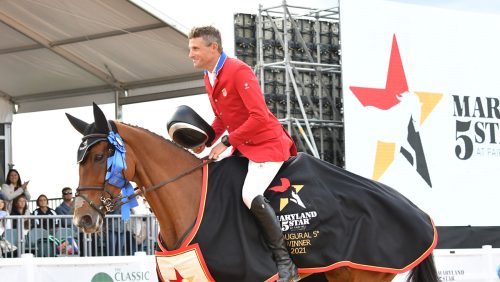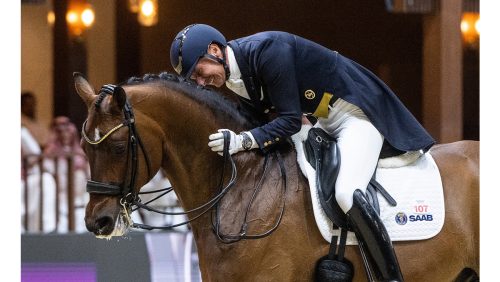With the 2012 U.S. dressage team now selected, our columnist is already thinking of ways to make the next team even stronger.
Of all sports, I think dressage most resembles life. The seasons are long; defeat is familiar. Repetition eventually, but sometimes painfully slowly, makes you and your horse perform better. It’s not necessarily fun or safe all the time. And just as things start to jell, the preparation feels right, and the goal is in sight, the horse comes up lame.
Life as a professional can be a rollercoaster ride, since we’re dependent on the health and progress of our ever-changing equines. And still, as frustrating as it can be, it’s all worth it when that flying change that was so difficult is suddenly easy and clean, the piaffe truly feels like a trot in place, and the connection is reliable.
After accompanying our elite riders around the country and the world in my role as U.S. Equestrian Federation Dressage Technical Advisor, observing, training, criticizing and praising them, I have a good grasp of the state of our dressage union. This country is blessed with lots of talent, has a sizable population of people passionate about dressage and a fair amount of gifted horses. But when Americans look for international success, there are some definite obstacles that hinder us from competing against the Europeans on a level playing field.
To start with, there is the “lack of proximity,” because of the size of our country, which greatly complicates our ability to work and learn together. With the notable exception of the intense four-month Florida season, we don’t have sufficient numbers of shows available over the year, or country wide, for the riders to get in the ring often enough. As a result, they don’t get enough practice and can think of every show as a huge event. In Europe, the strongest competitive countries are so close to each other that it’s never more than a day trip to reach a competition, and there are plenty of choices as to where to show.
Recruiting Relationships
Americans are horse poor and ring rusty compared to our European counterparts. By that I mean that each accomplished rider here usually is limited to one FEI competition horse. Although we aren’t to blame for our huge distances, this situation is at least partially our own fault.
We have a number of viable professionals and past U.S. team riders who didn’t try out for the Olympics this year and are not even competing at the FEI levels. These riders aren’t retired from competition; they’re busy training and teaching. So busy, in fact, that for years they appear to have had no time or interest in producing new horses coming up the ranks. It looks like some successful riders are simply waiting for a sponsor to insert a ready made Grand Prix horse under their seats, while they are too occupied or unmotivated to school their own.
Riders have learned from the past that they can get on our team on prefab horses, mostly imported from Europe. Sometimes they could even get a medal. But that was yesterday, and a new age is dawning, where to play at the very top you need a close, ongoing relationship with your horse. What made the magic disappear for quite a while when Totilas was sold? The stallion looked, moved and performed all his exercises basically the same as before, but the chemistry that existed between horse and rider when he was piloted by Edward Gal had evaporated. And why weren’t we surprised? Wasn’t the reason we became involved with dressage, which means training, the fact that there is training involved?
ADVERTISEMENT

Only after years of training together can a rider expect to create the chemistry that combinations like Totilas and Edward Gal shared. Photo by Sara Lieser
Admittedly it takes time, money, tears, disappointments and lots of sacrifice in other areas to produce just one Grand Prix horse from “scratch.” I know the drill since I’m on my 16th green Grand Prix horse. For sure, all my past horses were not stars, but one, Metallic, was on two U.S. medal teams. Although in the end, you may not have a Uthopia or a Totilas, you could be out there competing on the international circuit, gaining experience and giving us much needed visibility overseas.
On the 2011 Pan American gold-medal team, we had four U.S.-trained horses, and two of them were U.S.-bred. Paragon was born under the watchful eye of his rider-owner Heather Blitz, and there is no mistaking that they have a very close relationship. Hopefully it will also serve our present Olympic team well that all our riders have been long-time partners with their mounts.
Keep The Pipelines Flowing
We desperately need many more horse/rider combinations like that to create depth, but immediately the question of who or what will finance this program comes to mind. It’s easy to point to Isabell Werth and praise her proficiency in bringing horses along when she has a fabulous backer like Madeleine Winter-Schulze! It’s not all about solid sponsorship, however. Some capable and educated riders who have financial backing haven’t necessarily produced new horses, while people who had to tough it out themselves have.
Any rider who is serious about staying in the game has to be busy creating a pipeline of horses to keep her/him in the ring and available for Games to come. The best way is to attempt to acquire affordable young horses, since there are very few even partially trained horses out there worth the enormous prices they command. And there is always the option of bartering training for the ride on a great prospect, which benefits all parties. We have many accomplished and experienced riders without a horse who would welcome a partnership with an owner or breeder! Now, when we have an educational system of national coaches in place, we need to have the horses to train and the riders willing to do the work.
It appears dressage isn’t the only equestrian discipline lacking a solid base. George Morris has often expressed his frustration with the situation in show jumping, and when I spoke with him recently, he had some choice words for what he called the “complacency of the riders.” Mr. Morris could just as well be talking about dressage when he was quoted in the Chronicle just a few weeks ago, saying: “People are comfortable at home, and when you are comfortable in a competition situation, you get a bit deluded about how things go. We have to have a very strong base on our soil, and then the people who are ready should go to Europe to compete as a finishing school.”
It looks like we’re in the same boat, but at least in jumping things are less predictable than in dressage. A miracle round could happen on the jumper course to upset all the predictions, while this is indeed a rare event in the dressage arena.
On To London
The competition in London this summer will be incredibly intense. Anyone who has followed the results over the last year is aware of how fast things are changing in the ranks and how the scores are soaring as the Games get closer. The spotlight moves from one sensational new horse to another, and they all seem to offer endless possibilities. Whenever a new star arrives on the scene, that horse gives its team a boost, and the rapid changes in team status are fascinating to follow, especially since this is very much a new phenomenon on the world dressage scene.
ADVERTISEMENT
A few weeks ago, the U.S. dressage team was selected at the U.S. Equestrian Team Foundation headquarters in Gladstone, N.J. It was an extremely well organized and smoothly run event. The grounds have never looked more beautiful, the judging was spot on, and the quality of the competition high. Horses I have followed over the entire show season stepped up their performances to a whole new level, and there was no room for error. One mistake was a disaster, two would cost you the placing. It started to look like a “fault and out” division by the second weekend, and until the end of the last Grand Prix Special, we weren’t sure who our three team members and one individual would be.
The riding overall was sophisticated, and the atmosphere in the barns and during training, warm-up and competition was focused, yet positive and friendly. Naturally, some of the riders had more horse under the hood than others, but we can be proud of how well each horse was presented. In the end we’re blessed with a great team of experienced horses and riders: Steffen Peters on Ravel, Tina Konyot on Calecto, Jan Ebeling on Rafalca. Riding as an individual, we have Adrienne Lyle on Wizard making her debut as a USEF team member on the highest international level.
As a bonus, we had Stephen Colbert giving us a huge leg up by finally admitting dressage to prime time television on Comedy Central’s “The Colbert Report.” We thank the Romney presidential campaign for the opportunity and embrace the foam fingers and the jokes. They even picked clips of Rafalca at her best and spelled dressage correctly. Life is good!
During the trials, the USEF had an in-person meeting for the Active Athletes Committee, and we invited all the riders in the competition to attend. The result was a most productive exchange of ideas for improving our sport countrywide. Although we conduct riders’ meetings at all the major CDIs, I never before had the feeling that the athletes had this kind of an inspired exchange while thinking of themselves as a part of a nation, rather than a region.
Americans are great visionaries. We now need to envision a plan for the next four years and beyond by pooling our resources in training ability and by starting and producing new horses at home, to make sure there is an even better life for American dressage after these Olympics!
In the meantime, keep your fingers crossed for us in London.
Anne Gribbons is the U.S. Equestrian Federation Technical Advisor for dressage. She has trained and shown 15 horses of her own to Grand Prix and competed in 10 national championships as well as in Europe, including the Aachen CHIO (Germany). Seven of her horses have been U.S. Dressage Federation Horse of the Year, and she was a member of the 1995 Pan American silver medal-winning team for the United States. Anne is a Fédération Equestre Internationale five-star judge, and she’s been a member of the FEI Dressage Committee since 2010. She started contributing to Between Rounds in 1995.
If you enjoyed this article and would like to read more like it, consider subscribing. The original version of “Looking Beyond The Olympics” ran in the July 16, 2012, issue. Check out the table of contents to see what great stories are in the magazine this week.















